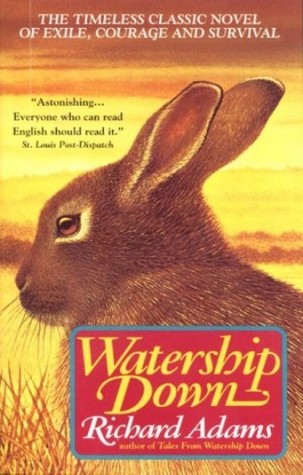written by David Steffen
 Watership Down is a survival adventure book written by Richard Adams published in 1972 that might arguably be classified as fantasy as well, which was adapted into a well-known children’s movie in 1978. It follows a group of young bachelor rabbits who run away from their warren when one of them has a premonition of coming disaster. The book follows them as they try to find a suitable location for a new warren and try to settle back down.
Watership Down is a survival adventure book written by Richard Adams published in 1972 that might arguably be classified as fantasy as well, which was adapted into a well-known children’s movie in 1978. It follows a group of young bachelor rabbits who run away from their warren when one of them has a premonition of coming disaster. The book follows them as they try to find a suitable location for a new warren and try to settle back down.
Multiple rabbits are point of view characters throughout the book, but the most important rabbit to the story is Fiver, the one who has the premonition of disaster (an upcoming construction site where the warren is located), which might be psychic or might just be intuition based on the sudden incursion of signs announcing the construction project. Hazel is the one who first believed Fiver’s warning and helped convinced the others to make their escape. Most of the group are pretty scrawny, secondary members of the warren, except for Bigwig, who is a member of the Owsla, the warren’s internal enforcers. And then there’s Blueberry who seems to not think like a rabbit at all, coming up with new strategies that no other rabbit would even consider.
As they travel across the English countryside they come across other dangers, and meet rabbits from other warrens, and try to avoid humans as much as possible. Before their flight, they have never left the area immediately surrounding their warren, so they come across many things that seem fantastical from their points of view. All they really want is a stable and happy place to live, trying to find food and eventually mates (can’t establish much of a warren with only male rabbits!).
The book is marginally speculative, if you like to have something of the fantastical in the stories. Fiver’s premonitions and Blueberry’s unrabbitlike thinking are the sort of things that might be considered speculative. And the ease with with different species of animals communicate with each other and rabbits strategize their actions together. Besides that the rabbits have a rich tradition of storytelling wherein they tell trickster myths about El-ahrairah, the greatest of rabbits, Prince of a Thousand Enemies. The story as a whole is given a sense of realism despite this speculation, because the author apparently did a lot of research into rabbit behavior and rabbit social structures and the like in preparation to write this story, that it all feels very real.
I’ve heard the book/movie referenced often enough that I wanted to give it a try. I had so few preconceptions about the story that I assumed that it was a nautical tale from the title. The myths were my favorite part of the book, to the point that I was always disappointed when one of the myths ended–the real-world stuff was interesting enough, but paled next to the myths for me. Overall I’d recommend it, especially if you like to get references to classic literature, since this one does seem to come up pretty regularly. It’s a compelling tale of survival.
